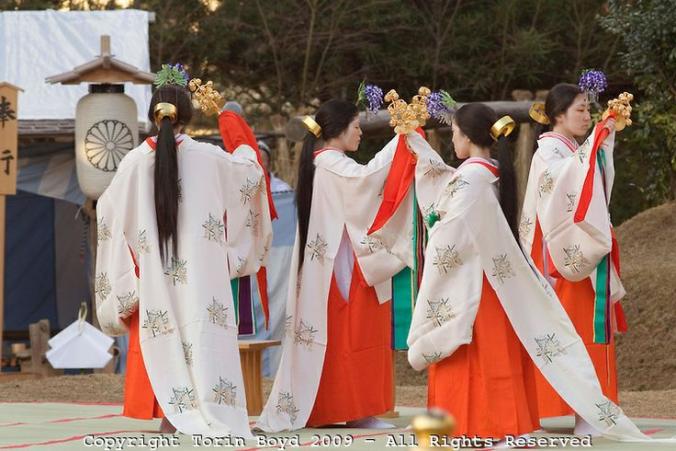Dec. 17, 2009: These are miko shrine maidens performing a special Shinto Shaden Kagura dance ritual during the annual On-Matsuri festival, a traditional Shinto religious festival held at the Kasuga Wakamiya Shrine in the ancient Japanese city of Nara, Japan. In older days, miko were considered shamans, but today they take on a more lighter role as priestesses or ceremonial duties. The traditional miko costume is an elaborate multi layered costumed kimono comprised of a red hakama (long, kimono type trousers), a white haori or kimono outer layer, white or red hair ribbons (white symbolizes purity), and in the case of Kasuga Shrine miko, they wear wisteria flowers in their headdress, symbolic if the shrine's patron the Fujiwara clan. ..This festival which dates back to the twelfth century was first started by Tadamichi Fujiwara, Chief Advisor of the Emperor in 1136 as a way to pray for the eradication of a plague as well as hopes of a bumper crop in the coming year. For many centuries this festival included both Shinto and Buddhist participants, but when Shinto was made the official state religion during the Meiji period (1867-192), the government instituted a policy of separation between Buddhism and Shinto. Ever since, this festival has strictly been a Shinto ceremony held every December 17 on the grounds of Kasuga Taisha Grand Shrine, which Kasuga Wakamiya Shrine is a branch of. During the festival, the Divine Spirit of Wakamiya is temporarily enshrined in the Otabisho, a special shrine set up for just this festival. Several official religious rites are performed throughout the day, as well as the Jidai Gyrotesu, or "Precession of Eras" in which parade participants displays traditional Japanese costumes from various era of Japanese history. There are also displays of court music and dance which goes on well into the night.
-
- Categories
- Architecture
- Art
- Cars & Motorcycles
- Design
- DIY & Crafts
- Education
- Film, Music & Books
- Fitness
- Food & Drink
- Gardening
- Geek
- Hair & Beauty
- History
- Holidays & Events
- Home Decor
- Humor
- Kids
- Women's Fashion
- Men's Fashion
- Leisure & Outdoors
- People
- Photography
- Products
- Science & Nature
- Sports
- Technology
- Travel & Places
- Weddings
- Other
- Property
- Animal
- Celebrities
- Health & Fitness
- Illustrations & Posters
- Quotes
- Services
- Renovation
- Home Building
- Business
- Toys
- New
- Popular
- Gifts
- Videos
- Help / Contact Us
- Terms & Privacy
- What is InterestPin


